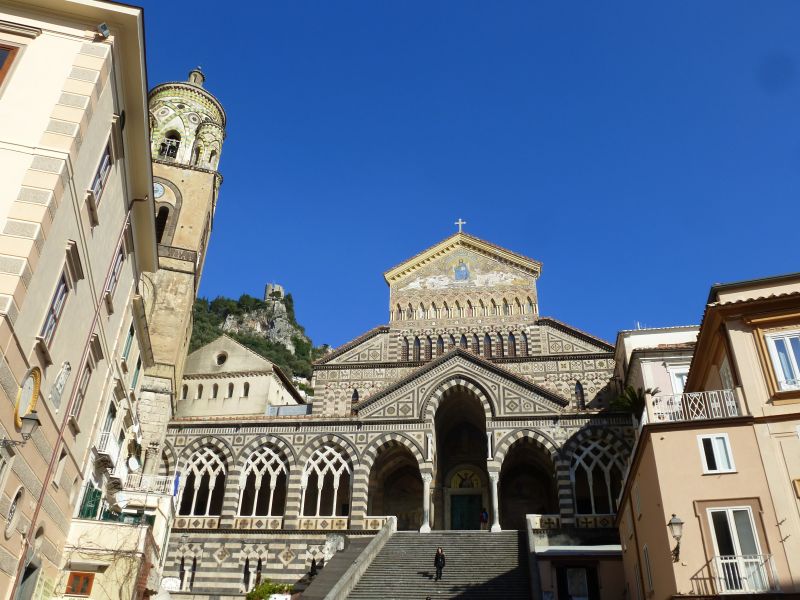The cathedral of Amalfi, main place of Catholic worship in the city of the same name, it is a structure dating back to the 9th century with architectural features ranging from Romanesque to Baroque to Rococò. The cathedral is dedicated to the apostle Saint Andrew. Mainly of Arab-Norman Romanesque architectural style, it has been remodeled several times, adding Romanesque style, Byzantine, gothic and baroque elements. The cathedral includes the annexed Basilica of the Crucifix also dating back to the 9th century. Also there you can find the Crypt of Sant’Andreaand the famous Cloister of Paradise.

History of the cathedral of Amalfi
The cathedral which was built next to the older Basilica which in turn was built on the ruins of a temple, when the Maritime Republic began to establish itself as a commercial power. It was completely renovated in 1203, in the Arab-Norman forms introduced by the conquerors. Reworked around the 1570, it was also rebuilt after that 24 December 1861 under the action of a strong wind, a section of the crowning of the facade, in a bad state of conservation, he fell once or twice into the atrium below. The favorable opinion of the stylistic restoration of the Giunta delle Belle Arti meant that, for slight damage, the stratifications on the facade (of the Renaissance era, baroque, etc.) were canceled, having the cathedral rebuilt in the style of the architect Lorenzo Casalbore, who demolished the distinguished portico, the capitals, the frames, the same plaster and the bases and pilasters of the eighteenth century.
The interior of the cathedral of Amalfi
The interior of the Cathedral, with the coffered ceiling, it is characterized by a central nave, characterized by the large wooden crucifix of the thirteenth century.; at the top instead, on the altar,there is the canvas of the Martyrdom of St.. Andrea; two majestic Egyptian granite columns support the triumphal arch, further on there are two Tortile Columns and the two Pulpits. In the left aisle there is the Mother of Pearl Cross, brought from the Holy Land by Mons. Marini, beside the Baptistery in Egyptian red porphyry e, going down the aisle, in the side chapels some Canvases by Silvestro Mirra and his pupils. In the right aisle we find the Reliquary Bust of St.. Andrea of the century. XVI and, on the door, a large canvas depicting St.. Andrea and S. Matteo.
The Crypt of the Amalfi Cathedral
The body of St.. Andrea, the first disciple of Jesus and patron saint of Amalfi. After the martyrdom of Sant’Andrea, according to tradition, his relics were moved from Patras to Constantinople. Local legends say that the relics were sold by the Romans. Here they remained until 1208 When, during the fourth crusade, the relics were brought to Amalfi, by Cardinal Pietro Capuano, native of Amalfi.
The Crypt is presented today in the Baroque form dated in 1600 with scenes from the Passion of Jesus, set among rich and elegant stucco decorations. The central altar, in fine marble, it is the work of Domenico Fontana. The large bronze statue is the work of Michelangelo Naccherino. Next to it there are the marble statues representing San Lorenzo and Santo Stefano. The sacred relics are enclosed in a silver urn, placed under the central altar, work of Domenico Fontana.

The exteriors of the cathedral of Amalfi
To dominate the coastal town, at the top of a suggestive staircase, the mosaic, rich in shapes and bright colors, which covers the facade of the Cathedral, and representing Christ enthroned in the midst of the Evangelists. The Cathedral has a splendid Romanesque bell tower, finished in 1276, covered with mosaic majolica and restored in 1929. Beyond the portico is the entrance door to the Cathedral, in bronze, coming from Constantinople, as a gift from an Amalfi patrician.


